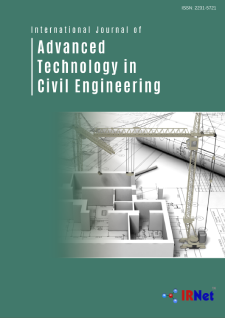International Journal of Advanced Technology in Civil Engineering IJATCE
ISSN: 2231-5721

Abstracting and Indexing


IJATCE
Multi-criteria Contractor Selection Framework for Indian Construction Projects
Ambawrish Pati
School of Planning and Architecture, New Delhi
Abhijit Rastogi
School of Planning and Architecture, New Delhi
Virendra Kumar Paul
School of Planning and Architecture, New Delhi
Abstract
In this paper contractor selection practice in India has been analyzed in detail to find out the gaps in the prevailing system & also compared with the selection systems outside India. This study aims to develop a multi-criteria contractor selection framework that can incorporate multiple evaluation criteria along with the relative weightage. In this study, it has been identified that in India, as per the guidelines the contractor selection in the case of most popular Design Bid Build (DBB) projects is done based on Least Cost Selection (LCS) only. In LCS, the final selection is based on cost or bid price only. In some cases, Quality & Cost Based Selection (QCBS) is applied for contractor selection. However, QCBS is mainly used for consultant selection or selection of service providers. On the other hand, in many other counties, there are systems that follow multiple criteria for contractor selection to ensure the overall performance of the contractor. Hence, in India, there is a need for a structured, multi-criteria contractor selection system. The system should cater to the objective of contractor selection in the case of DBB projects & also should be responsive to the present need for selection based on multiple criteria.
Recommended Citation
[1] A. A. Ola and A. O. Michael, “Impact of Contractors’
Prequalification Criteria on Civil Engineering Project Quality
Performance,” Int. J. Adv. Eng. Manag. Sci., vol. 3, no. 9, pp. 941–
947, 2017, doi: 10.24001/ijaems.3.9.7.
[2] J. R. San Cristóbal, “Contractor Selection Using Multicriteria
Decision-Making Methods,” J. Constr. Eng. Manag., vol. 138, no. 6,
pp. 751–758, Jun. 2012, doi: 10.1061/(ASCE)CO.1943-
7862.0000488.
[3] E. K. Zavadskas, Z. Turskis, and J. Tamošaitienė, “Contractor
Selection of Construction in a Competitive Environment,” J. Bus.
Econ. Manag., vol. 9, no. 3, pp. 181–187, Sep. 2008, doi:
10.3846/1611-1699.2008.9.181-187.
[4] D. Puri and S. Tiwari, “Evaluating The Criteria for Contractors’
Selection and Bid Evaluation,” p. 5.
[5] Y. Konno, “Relationship between construction performance
evaluation and contractor characteristics in Japan,” Cogent Bus.
Manag., vol. 5, no. 1, p. 1486169, Jan. 2018, doi:
10.1080/23311975.2018.1486169.
[6] O. J. Olaniran, “The effects of cost-based contractor selection on
construction project performance,” J. Financ. Manag. Prop. Constr.,
vol. 20, no. 3, pp. 235–251, Nov. 2015, doi: 10.1108/JFMPC-06-
2014-0008.
[7] M. Sönmez, J. B. Yang, and G. D. Holt, “Addressing the contractor
selection problem using an evidential reasoning approach,” Eng.
Constr. Archit. Manag., vol. 8, no. 3, pp. 198–210, Mar. 2001, doi:
10.1108/eb021182.
[8] S. Deep, D. Singh, and S. A. Ahmad, “A Review of Contract
Awards to Lowest Bidder in Indian Construction Projects via Case
Based Approach,” Open J. Bus. Manag., vol. 05, no. 01, pp. 159–
168, 2017, doi: 10.4236/ojbm.2017.51015.
[9] “Mannual for Procurement of Works.” Department of Expenditure,
Ministry of Finance, Government of India, 2019. Accessed: Jun. 03,
2022. [Online]. Available:
https://doe.gov.in/sites/default/files/Manual%20for%20Procurement
%20of%20works%202019.pdf
[10] OECD, Business Models for the Circular Economy: Opportunities
and Challenges for Policy. OECD, 2019. doi: 10.1787/g2g9dd62-en.
[11] A. Moza and V. K. Paul, “Analysis of Claims in Public Works
Construction Contracts in India,” J. Constr. Dev. Ctries., vol. 23, no.
2, pp. 7–26, 2019, doi: 10.21315/jcdc2018.23.2.2.
[12] A. Sawhney, R. Agnihotri, and V. Kumar Paul, “Grand challenges
for the Indian construction industry,” Built Environ. Proj. Asset
Manag., vol. 4, no. 4, pp. 317–334, Sep. 2014, doi:
10.1108/BEPAM-10-2013-0055.
[13] R. Singh, “Delays and Cost Overruns in Infrastructure Projects:
Extent, Causes and Remedies,” Econ. Polit. Wkly., vol. 45, no. 21,
pp. 43–54, 2010.
[14] S. Das, A. Rastogi, and K. Kumar, “Applicability of Risk
Assessment Tools and Techniques for a Construction Project,” Feb.
2022, doi: 10.5281/ZENODO.5956022.
[15] “General Financial Rules.” Department of Expenditure, Ministry of
Finance, Government of India, 2017. Accessed: Jun. 03, 2022.
[Online]. Available:
https://doe.gov.in/sites/default/files/GFR2017_0.pdf
[16] “Defence Procurement Mannual.” Ministry of Defence, Government
of India, 2009. [Online]. Available:
https://www.mod.gov.in/sites/default/files/DPM2009.pdf
[17] “CPWD Works Mannual.” Central Public Works Department,
Government of India, 2019. [Online]. Available:
https://www.cpwd.gov.in/Publication/Work_Manual_2019_2003201
9.pdf
[18] “Standard Operating Procedures for CPWD Works Mannual.”
Central Public Works Department, Government of India, 2019 [Online]. Available:
https://cpwd.gov.in/Publication/SOPs_to_Work_Maunal_2019_20_
March_2019.pdf
[19] Government of Canada, “Buy and Sell: Public Services and
Procurement, Canada,” 2020. https://buyandsell.gc.ca/policy-and-
guidelines/supply-manual/section/5 (accessed Jun. 03, 2022).
[20] OECD, European Union, and Joint Research Centre - European
Commission, Handbook on Constructing Composite Indicators:
Methodology and User Guide. OECD, 2008. doi:
10.1787/9789264043466-en.
[21] M. Lemke, S. Smith, T. Kolar, and M. Stachowiak, “Implementing
the EU Directives on the selection of economic operators in public
procurement procedures,” SIGMA Papers 56, Oct. 2018. doi:
10.1787/f511e46f-en.
[22] X. Meng and M. Sun, “Construction tender evaluation practice in
China,” vol. 10, no. 4, p. 8, 2015.
[23] A. Association General Contractors of America and N. Facilities
Administrators, “Construction Management at Risk Benefits,
Criteria and Justification.” AGC, Jun. 2020. Accessed: Jun. 03,
2022. [Online]. Available:
https://cdn.ymaws.com/www.nasfa.net/resource/resmgr/learning_ser
ies/AGC-NASFA_CM@Risk_-_Final_-_.pdf
[24] P. Project Management Institute and KPMG, “Revamping Project
Management: Assessment of Construction Projects & Corrective
Recommendations for Performance Improvement,” Ministry of
Statistics and Programme Implementation, Government of India,
Jun. 2019.
[25] R. Chouksey and V. K. Paul, “A Model for Detection and Prevention
of Unbalanced Bid in the Public Work Procurement Process in
India,” Eng. Technol. J., vol. 06, no. 12, Dec. 2021, doi:
10.47191/etj/v6i12.04.
[26] S. K. Shrestha, “Average Bid Method – An Alternative to Low Bid
Method in Public Sector Construction Procurement in Nepal,” J.
Inst. Eng., vol. 10, no. 1, pp. 125–129, Aug. 2014, doi:
10.3126/jie.v10i1.10888.
[27] A. Moza and V. K. Paul, “Review of the Effectiveness of
Arbitration,” J. Leg. Aff. Dispute Resolut. Eng. Constr., vol. 9, no. 1,
p. 03716002, Feb. 2017, doi: 10.1061/(ASCE)LA.1943-
4170.0000204.
[28] V. K. Paul, C. Basu, and A. Rastogi, A handbook for construction
project planning and scheduling. 2017.
[29] S. Saifi, A. Rastogi, V. K. Paul, and D. Nayal, “Analysis of Critical
Delay Factors Causing Cost Overrun in Private Projects and their
Cost Minimization Strategies,” NICMAR, no. 1, p. 10, 2022.
[30] P. S. Yadav and V. K. Paul, “Complexities of Cost Overrun in
Construction Projects,” vol. 5, no. 2, p. 4, 2020.
[31] D. N. A. Ayettey and H. Danso, “Contractor Selection Criteria in
Ghanaian Construction Industry: Benefits and Challenges,” J. Build.
Constr. Plan. Res., vol. 06, no. 04, pp. 278–297, 2018, doi:
10.4236/jbcpr.2018.64019.
[32] W. Alzober and A. R. Yaakub, “Integrated Model for Selection the
Prequalification Criteria of Contractor,” Lect. Notes Softw. Eng., vol.
2, no. 3, pp. 233–237, 2014, doi: 10.7763/LNSE.2014.V2.128.
[33] T. L. Saaty, “What is the Analytic Hierarchy Process?,” in
Mathematical Models for Decision Support, G. Mitra, H. J.
Greenberg, F. A. Lootsma, M. J. Rijkaert, and H. J. Zimmermann,
Eds. Berlin, Heidelberg: Springer Berlin Heidelberg, 1988, pp. 109–
121. doi: 10.1007/978-3-642-83555-1_5.
[34] R. V. Vargas, “USING THE ANALYTIC HIERARCHY PROCESS
(AHP) TO SELECT AND PRIORITIZE PROJECTS IN A
PORTFOLIO,” p. 23, 2010